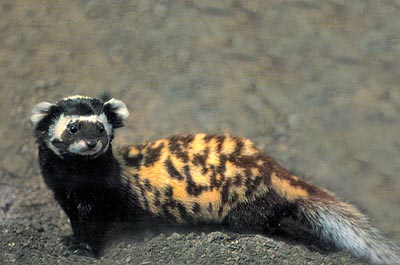|
| Query: marbled white | Result: 21st of 44 | |
Marbled Polecat (Vormela peregusna) - Wiki
| Subject: | Marbled Polecat (Vormela peregusna) - Wiki
| |

| Resolution: 400x265
File Size: 30128 Bytes
Upload Date: 2007:10:23 11:06:48
|
Marbled Polecat
From Wikipedia, the free encyclopedia
[Photo] Adult marbled polecat (Vormela peregusna). Source http://www.avestours.ro/index.php?id=1091166613&photo=1093717072 AVESTOURS. Date released 12. April. 2006. Photographer: Laszlo Szabo-Szeley ??AVESTOURS
The marbled polecat (Vormela peregusna) is a small mammal belonging to the monotypic genus Vormela within the Mustelinae subfamily. Vormela is from the Germanic word Wormlein, which means "little Worm". The term peregusna comes from pereguznya, which is Ukrainian for polecat. Marbled polecats are generally found in the dryer areas and grasslands of south-eastern Europe to western China. Like other members of Mustelinae, it can emit a strong smelling secretion from anal sacs under the tail when threatened.
Description
Ranging in length from 29???35 cm (head and body), the marbled polecat has a short muzzle and very large, noticeable ears. Limbs are short and claws are long and strong. While the tail is long, with long hair, overall pelage is short. Black and white marks the face, with a black stripe across the eyes and white markings around the mouth. Dorsally, pelage is yellow and heavily mottled with irregular reddish or brown spots. Tail is dark brown with a yellowish band in the mid-region. The ventral region and limbs are a dark brown. Female mass ranges from 295g up to 600g and males can range from 320g to 715g. Browse images
Distribution
The marbled polecat is found from south-east Europe to Russia and China. Range includes Bulgaria, Romania, Asia Minor, Lebanon, Syria, Israel, Palestine, Jordan, Iran, Afghanistan, north-western Pakistan, Yugoslavia, Mongolia, China, Kazakhstan and north to the Altai Steppes in Siberia. In 1998 marbled polecat was recorded on the Sinai Peninsula, Egypt.
Behavior
Marbled polecats are most active during the morning and evening. Their eye sight is weak and they rely on a well-developed sense of smell. Vocalization is limited and consists of shrill alarm cries, grunts and a submissive long shriek.
Marbled polecats are solitary and move extensively through their 0.5 to 0.6 km² home range. They generally only stay in a shelter once. When they encounter each other they are usually aggressive.
When alarmed, marbled polecats raise up on their legs while arching their back and curling their tail over their back with long tail hair erect. They also raise their head, bare their teeth and give shrill, short hisses. If threatened, they can expel a foul-smelling secretion from enlarged anal glands under their tail.
To dig, such as when they are excavating dens, marbled polecats dig out earth with their forelegs while anchoring themselves with their chin and hind legs. They will use their teeth to pull out obstacles such as roots.
Reproduction
Marbled polecats mate during March to early June. Gestation can be long and variable (243 days to 327 days). Parturition has been observed to occur from late January to mid-March. Delayed implantation allows marbled polecats to time the birth of their cubs for favorable conditions, such as when prey is abundant.
Litter size ranges from 4???8 cubs. Only females care for the young. Cubs open their eyes at around 38???40 days, are weaned at 50???54 days and leave their mother (disperse) at 61???68 days.
Ecology
Habitat
Marbled polecats are found in open desert, semi-desert, semi-arid rocky areas in upland valleys and low hill ranges, steppe country and arid subtropical scrub forest. They avoid mountainous regions. Marbled polecats have been sighted in cultivated areas such as melon patches and vegetable fields.
Burrows of large ground squirrels or similar rodents such as the great gerbil (Rhombomys opinus) and Libyan jird are used by marbled polecats for resting and breeding. They may also dig their own dens or live in underground irrigation tunnels. In the winter, marbled polecats will line their den with grass.
Diet
Marbled polecats are known to eat ground squirrels, Libyan jirds (Meriones libycus), Armenian hamsters (Cricetulus migratorius), voles, mole rats (Spalax lecocon ehrenbergi), house mice (Mus musculus), and other rodents, small hares, birds, lizards, frogs, insects (e.g. snails, beetles, crickets) as well as fruit and grass. They are also recorded as taking small domestic poultry such as chickens and pigeons as well as stealing smoked meat and cheese.
Conservation Status
V. peregusna is listed in the IUCN Red List of Threatened Species and was assessed vulnerable in the 1996 evaluation. It is thought that decline in marbled polecat populations may be due to habitat destruction (cultivation), rodenticide and reduction in available prey.
Remarks
The marbled polecat had once been sought for its fur; also known as fitch in the fur trade.
In 1945 it was recorded that Kabul shopkeepers kept marbled polecats to exterminate rodents.
Other names for the marbled polecat include aladzhauzen (Turkmen); berguznya (Kuban); chokha (Kalmuck); fessyah (stinky in Arabic); abulfiss (Arabic); Ma-nai-ho (Chinese); myshovka (Terek cossak dialect); pereguznya, pereguzka, perevishchik (Ukrainian); perevozchik (southern Russia); perewiaske (Polish); suur-tyshkan (Kyrgyz); putois marbr??, putois de Pologne (French); Tigeriltis (German); mottled polecat; sarmatier; Syrian marbled polecat and tiger polecat.
There are several subspecies of V. peregusna, including:
V. p. alpherakyi
V. p. euxina
V. p. negans
V. p. pallidor
V. p. peregusna
V. p. syriaca
http://en.wikipedia.org/wiki/Marbled_Polecat
| The text in this page is based on the copyrighted Wikipedia article shown in above URL. It is used under the GNU Free Documentation License. You may redistribute it, verbatim or modified, providing that you comply with the terms of the GFDL. |
|
Comments |
|---|
| | Guest |
|
| ching chang chong |
| | Guest |
|
Scientific Name: Vormela peregusna (Güldenstädt, 1770)
Synonyms: Mustela peregusna Güldenstädt, 1770
Common Names:
English – Marbled Polecat, European Marbled Polecat
French – Putois Marbré
Spanish – Turón Búlgaro |
^o^
Animal Pictures Archive for smart phones
^o^
|
|
|